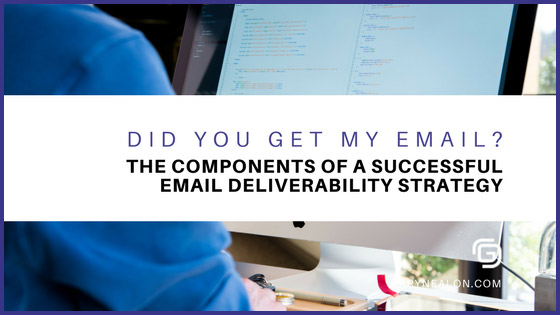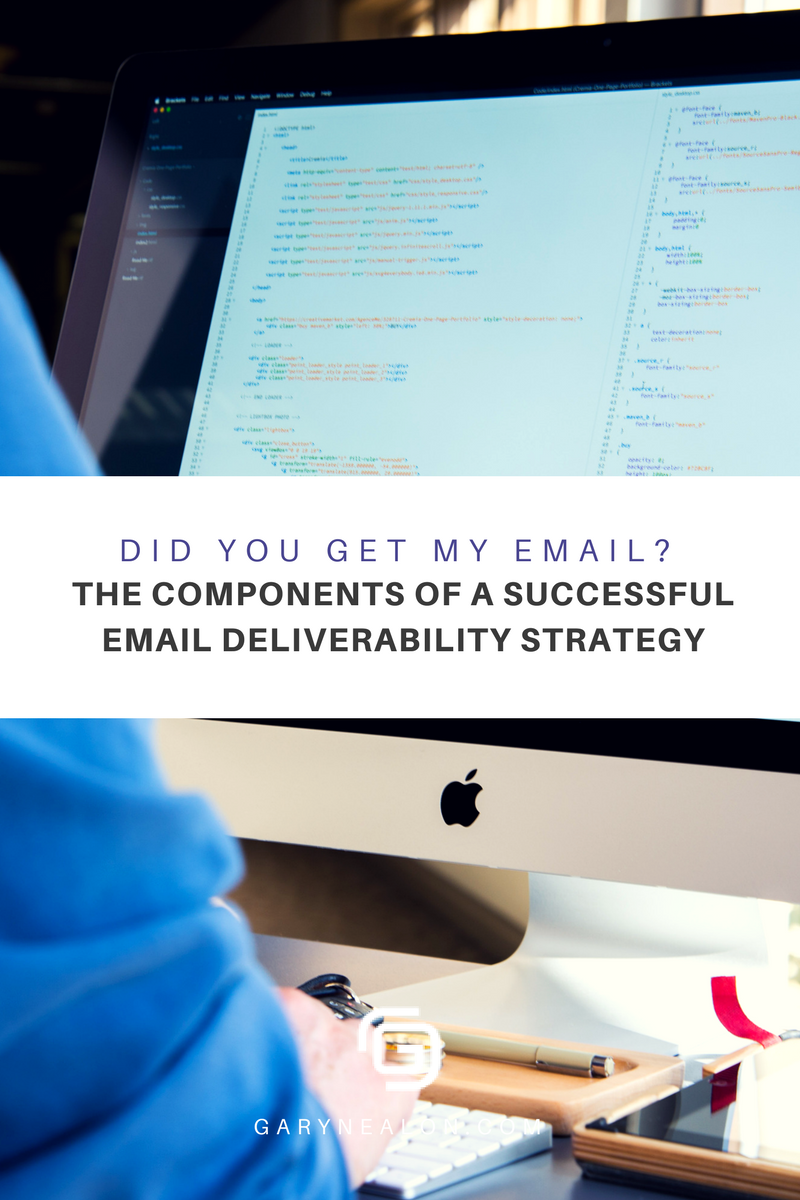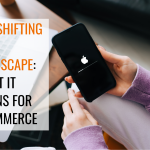Have you gotten an email today? Of course you have, probably several. If you haven’t, let me know, and I’ll send you one!
If you’ve heard recently that email is dead, know this, email didn’t die. It’s alive and well. Go to the inbox of the primary email address you’ve had for at least a year and see how many emails you got today and then go and see how many you got exactly one year ago today.
Email is either something that you despise but still consider it a necessary evil of doing business, or you have concluded that email can be a contributing member to your arsenal of marketing tools, which if implemented correctly, can increase your revenues.
In order to have success at email marketing you need to understand email deliverability. This article will give you a strong foundation for achieving your goals when it comes to email marketing.
Email Deliverability
While it’s important to provide great headlines and persuasive text in your email to increase engagement, there are several other factors to consider that take place behind the scenes of sending an email.
Today I’m going to take you behind the curtain that many business owners have yet to open. Behind this curtain, you are going to learn tried and true tactics that will get your emails opened, read and responded to.
A successful email strategy is not complicated once you understand all the components and definitions. There are several important factors that we’ll cover, so as you read through the terms and definitions, you will begin to view emails, (no pun intended) in a whole new light.
Email Terms and Definitions
Deliverability
 To define deliverability, you need to divide the number of emails delivered by the number of emails sent. Deliverability is your success rate of emails reaching the intended audiences email address.
To define deliverability, you need to divide the number of emails delivered by the number of emails sent. Deliverability is your success rate of emails reaching the intended audiences email address.
Deliverability Rate = emails delivered / emails sent
Ex. 7,500 delivered / 10,000 emails sent = 75% deliverability rate.
The higher the deliverability rate, the better, however, you want to assure yourself that you’re maintaining a strong reputation with IP addresses, as they are the gatekeepers to your emails.
This statistic may give you a false sense of hope because it does not calculate whether your email made it to the primary email box or was sent to a promotional folder or spam filter. But knowing your emails are landing somewhere in your recipient’s inbox is a great start, and if they aren’t, with a few adjustments, we can get them to their primary box or off your list.
Hard Bounce
When an email you send gets rejected by an IP Address, it is called a bounce. It’s unavoidable at times, but there are strategies you can put in place to lower your bounce rate.
When you receive a hard bounce it’s because the recipient’s email address does not exist, the domain name does not exist, or something is misspelled in the email address. Or maybe the email server of the recipient has completely blocked delivery.
A good rule of thumb though is to keep the hard bounce rate at one.
If you get a hard bounce, retire that email at once. There is no need to risk your reputation and possibly make yourself a target for IP addresses by continuing to send to an email address that keeps getting a hard bounce. If the recipient is genuinely interested, or for that matter, even exists, then they will get back in touch with you somehow to get put on your list.
From a statistical standpoint, you want to keep your hard bounce rate as low as possible to maintain a high sender reputation.
Soft Bounce
A soft bounce occurs when an email is sent and is not able to be sent. It is recognized by the recipient’s server and you are notified. Typically, this is due to a full mailbox, the recipient’s email server being temporarily down, or the email you are sending is too large.
A good rule of thumb for soft bounces is to retire an email address if it soft bounces more than five times in a thirty day period. Soft bounces are not due to your negligence unless you are sending a file that is too large, but even so, you don’t want your metrics to be skewed by an email server that isn’t working or a recipient whose mailbox is full.
Inboxing Rate
The inboxing rate is the percentage of emails that make it to the intended recipient’s primary inbox.
Open Rates
When you have an email campaign a real indicator of success is your open rate. Some also call this metric open tracking. The open rate is typically shown as a percentage. The formula for calculating the open rate is:
Number of emails opened / number of emails sent = open rate
Ex. 3600 emails opened / 10000 emails sent = .36 or 36% open rate
It’s important to remember that open rates rely on images, so if you’re sending a text-only email, there is no way to tell if it was opened. In other words, your recipient’s email provider must be capable of displaying HTML with images and the option turned on in their settings.
If this setting is turned off, most email service providers compensate by adding click throughs into the formula of calculating open rates.
Click-Through Rate – (CTR)
 Your click-through rate is the percentage of users who click on a particular link to the number of total users who view an email. It’s commonly used as a standard measure of success in an online email campaign. Below are examples of click-thrus:
Your click-through rate is the percentage of users who click on a particular link to the number of total users who view an email. It’s commonly used as a standard measure of success in an online email campaign. Below are examples of click-thrus:
- Recipients who have opened the email and clicked through to another link on one or more device.
- Recipients who share a link on a social media platform from your email.
Examples of links that recipients commonly click through to:
- A link to your company website
- A link to register for an email list
- A link to download a coupon
- A link to go directly to a product description page
- A link to go directly to a blog post
- A link to go directly to one of your social media platforms
- A link to share some specific link on the recipient’s social media platforms
Double Opt-in Process
When a potential customer responds to a pop-up or otherwise subscribes to your list, they are sent a confirmation email that welcomes them to your email marketing list. Within in that email is a link to confirm their subscription. This helps to solidify that the person subscribing to your list does have a genuine interest in your product or service. It also indicates to you that they want to be on your list.
Having a double opt-in process in place will accomplish four things:
- Your marketing list will usually be smaller and higher quality.
- You know your recipients have read the email and completed the signup process.
- A double-opt in will filter out and spam bots and prevents people from using fake emails to sign up.
- The double opt-in process also reduces the possibility of you getting reported for sending spam.
A double-opt-in approach to building your list will enhance the integrity of your list and assure you that the people on your list are responsive.
Headlines or Subject Lines
This is the text that your recipients will see and is often the determining factor as to whether or not they will even open your email. This is one of the most important components of your email marketing campaign. So we will spend a little extra time on this area of your email deliverability strategy.
Although writing a captivating and catchy headline encourages the recipient to open your email, be aware that email service providers dislike spammy and salesy text in your subject lines.
Although there are a ton of methodologies for email titles or headlines, the few tips below will get your creative juices flowing to assist in helping you craft email headlines that get your emails opened.
- The ideal character number for an email title is 48 (this includes spaces) (ex. The Components of Email Deliverability Strategy). Several tests have shown that most email inboxes have this number of spaces before the title gets cut off.
- Know your target audience and know what gets their attention.
- Understand that the headline is not there to sell your prospect – it is there to get their attention. If you get their attention, the content of the email should sell them if that is your goal.
- Offer a promise or benefit and capture an emotion. Provoke curiosity.
- Speak in a language your prospect is used to hearing.
- Add an element of tension. (Ex. – What your college professor never told you in marketing 101).
- Make your headline a question that people want answers to. (Ex. – What you should never do when sending an email). Test email headlines by segmenting your list and see which headlines are getting the best open rates.
You could have a great deliverability rate, but if no one opens them, then you’re just sending emails. The first email is especially vital because you’ll want them to become engaged and be an active participant in your email campaigns.
Unsubscribing and Opt- Out Rate
For every email that you send, regardless of the email campaign or reason, you will always want to have a link that will permit the recipient to unsubscribe from your list. Typically it’s at the bottom of the email below your signature box.
As a general rule, when you’re setting up your email campaigns, you’ll want to make it just as easy for them to opt- out as it is to opt-in.
Ideally you would never want anyone to opt out, but when someone does, by doing so it increases the integrity of your email marketing list.
As the old saying goes, “some will, some won’t, so what, who’s next?”. It’s better to have an engaged list as opposed to a large list with low open rates and click throughs.
What’s next?
 Now it’s time to take a closer look at your email list or get one started properly to maximize results.
Now it’s time to take a closer look at your email list or get one started properly to maximize results.
Below are some steps you can implement right away to grow your email list:
- Take a closer look at the “no’s” – people who aren’t opting in, converting or engaging.
- Collect more emails through newsletter boxes, sidebar options, and giving away more tools and resources.
- Utilize content upgrades. Create lists, infographics, slideshares and instructional videos – to gain more email addresses.
- Quiz site visitors, offer some free content or other incentive, and for them to get their results, have them enter their email address You can also learn of topics to write about by doing this.
- Scrub and segment your list – Who have you not contacted recently, who is opening your emails and who isn’t, are you noticing any trends, etc.?
Research who you could partner with to exchange lists in a mutually beneficial manner. For example, if you have an online store selling women’s shoes, you could partner with a women’s purse store. - Subscribe to your competitor’s lists or a competitor in a different city or region using a general email address to see how they’re communicating to their audience.
- Focus on creating a quality list as opposed to a large list.
Email Deliverability is a metric that everyone needs to pay attention to and should not be looked at flippantly. If you pay attention to what we have discussed and implement the tips we’ve provided, you’ll have a valuable asset to drive sales at your disposal. By monitoring these important metrics, you’ll separate yourself from the majority of your competitors.
Successful email campaigns can quickly become a primary tool to encourage engagement, drive sales, stay in touch with past customers and continue to drive the value of your brand to every recipient on your list. We will expand on the points we just made in an upcoming post. Stay tuned….errr I mean, keep an eye out for that email 😉 – I expect to see you in my CTR stat page!









1 thought on “Did You Get My Email? The Components of a Successful Email Deliverability Strategy”